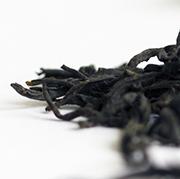Qimen Black historically has enjoyed greater prominence abroad than it did in China. In fact, the Anglicized name “Keemun” is more renowned than the “proper name” due to its greater honor away from home.
In fact, until a decade ago, this has always been the case. Let us look at its beginning:
Origins of Qimen Black

Qimen remained green tea country for over a thousand years until 1875. At that time, there was an official by the name of Yu Gan Cheng who returned back to his hometown in Qimen after being posted to Fujian.
On his way home, Yu passed by Wuyishan. There he saw how popular the local black tea Zhengshan Xiaozhong was as well as the commercial viability of this crop.
Upon his return to Qimen, he set up a tea business, modeling its production after Zhengshan Xiaozhong.
The natural climate of the Qimen tea producing area, coupled with his efforts resulted in a tea that was able to be a national hit, along with Fujian and Jiangxi black teas.
In 1883, Qimen Black commenced its foray into international waters. It was an instant hit. Some of it made its way into the English Breakfast Tea blend, taking its popularity further.
By 1939, Qimen produced 1/3 of the black teas in China and had been exported primarily to England but also to America, France, Germany, Holland, Denmark, Japan and numerous other European countries.
Unfortunately, the Japanese invasion and later the civil war impeded development.
The Difficult Years
Production of Qimen plummeted during the tumultuous years spanning the Sino-Japanese wars, World War II and the Chinese civil wars, just like virtually every other tea.

It was only in the 70s that the tea industry in Qimen saw light again. The founding of Anhui Province Agricultural Tea Research Institute brought about great innovation in the production of tea in Anhui province, including Qimen Black.
From the Chu Ye Zhong cultivar, cultivars Anhui No 1, No 3 and No 7 were developed and No 1 and No 3 in particular were identified as especially suitable for Qimen Black in 1984.
In spite of these advancements, Qimen Black production fell from a high of 3,506 tonnes in 1986 to 1/3 of that in 2001.
One of the main reasons was that since the economic reforms, many industries were privatized including tea. Green tea producers in the Huangshan area (including Qimen) begun to bid against each other for the top tea leaves. Export factories however, remained state owned and prices of tea leaves remained fixed.
Moving against the grain of free economy took its toll causing producers and growers of Qimen Black to suffer or switch to green tea.
In the past 5 or 6 years however, there is a shift in Chinese tastes towards black tea and not merely the commercial export grade black teas but higher grade ones.
Starting with the Jin Jun Mei craze, producers began to discover the economic value in producing black teas. Instead of using lower grade teas or summer teas for black tea, now good quality tea leaves typically used for green teas are being channeled to produce black tea. Increasingly spring teas as well as buds have been used in the production of black tea.
This seems consistent with the tea trends in China (notably Tieguanyin) where the swing is towards quality productions, signifying the future of China likely belongs in specialty tea as compared to commercial grades.
